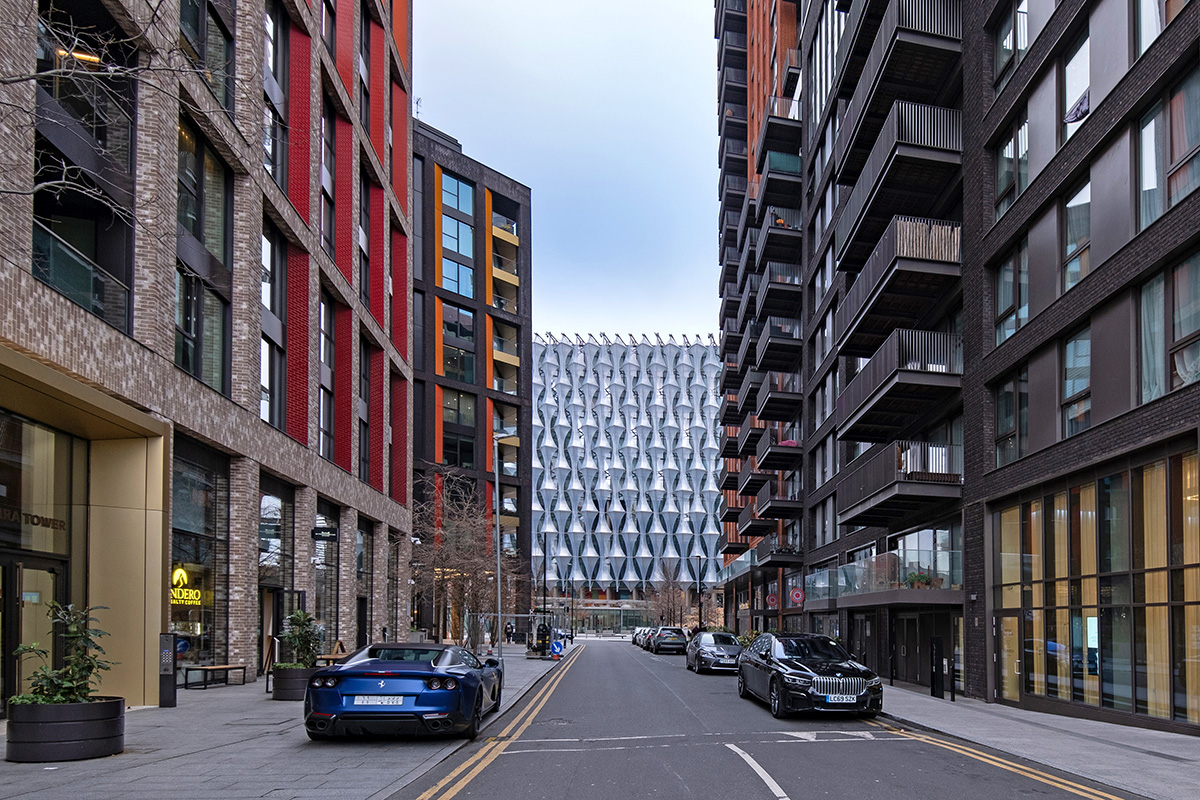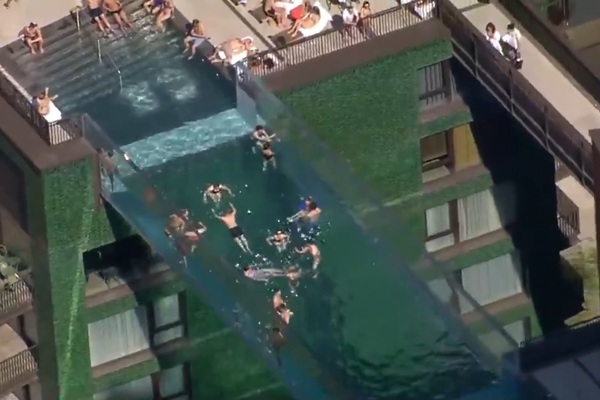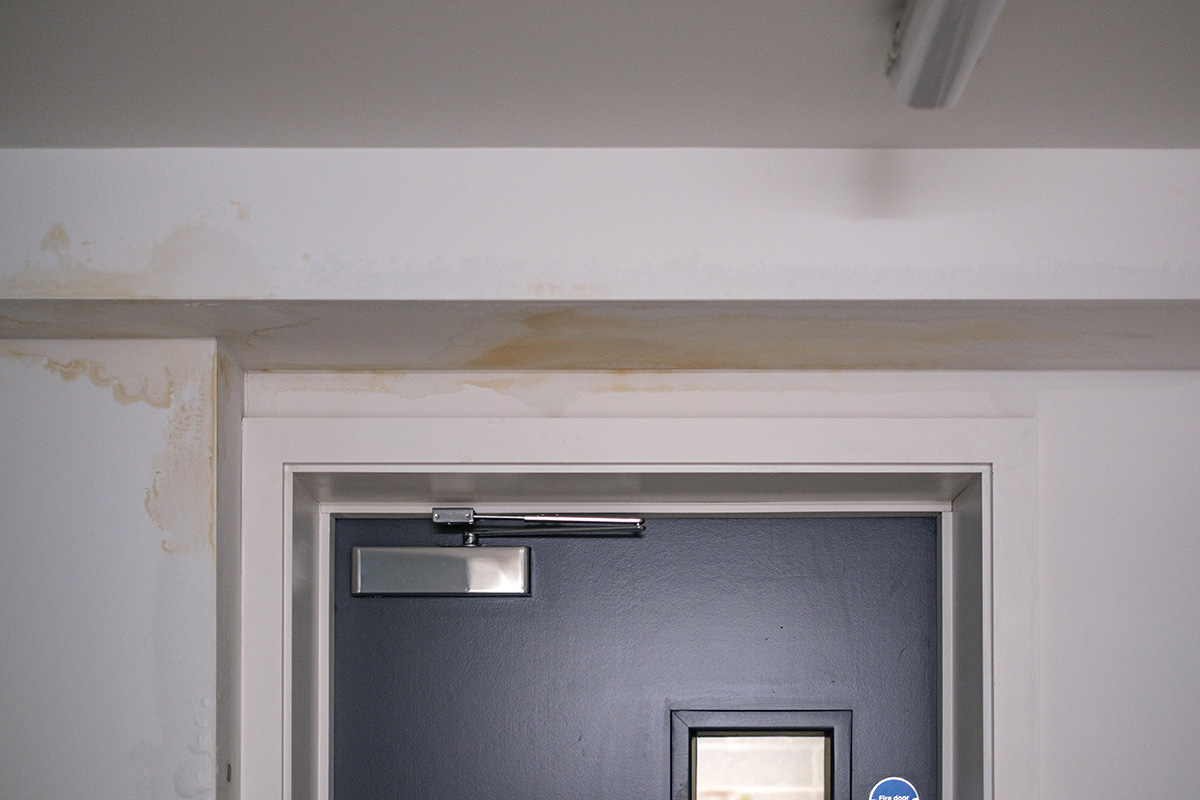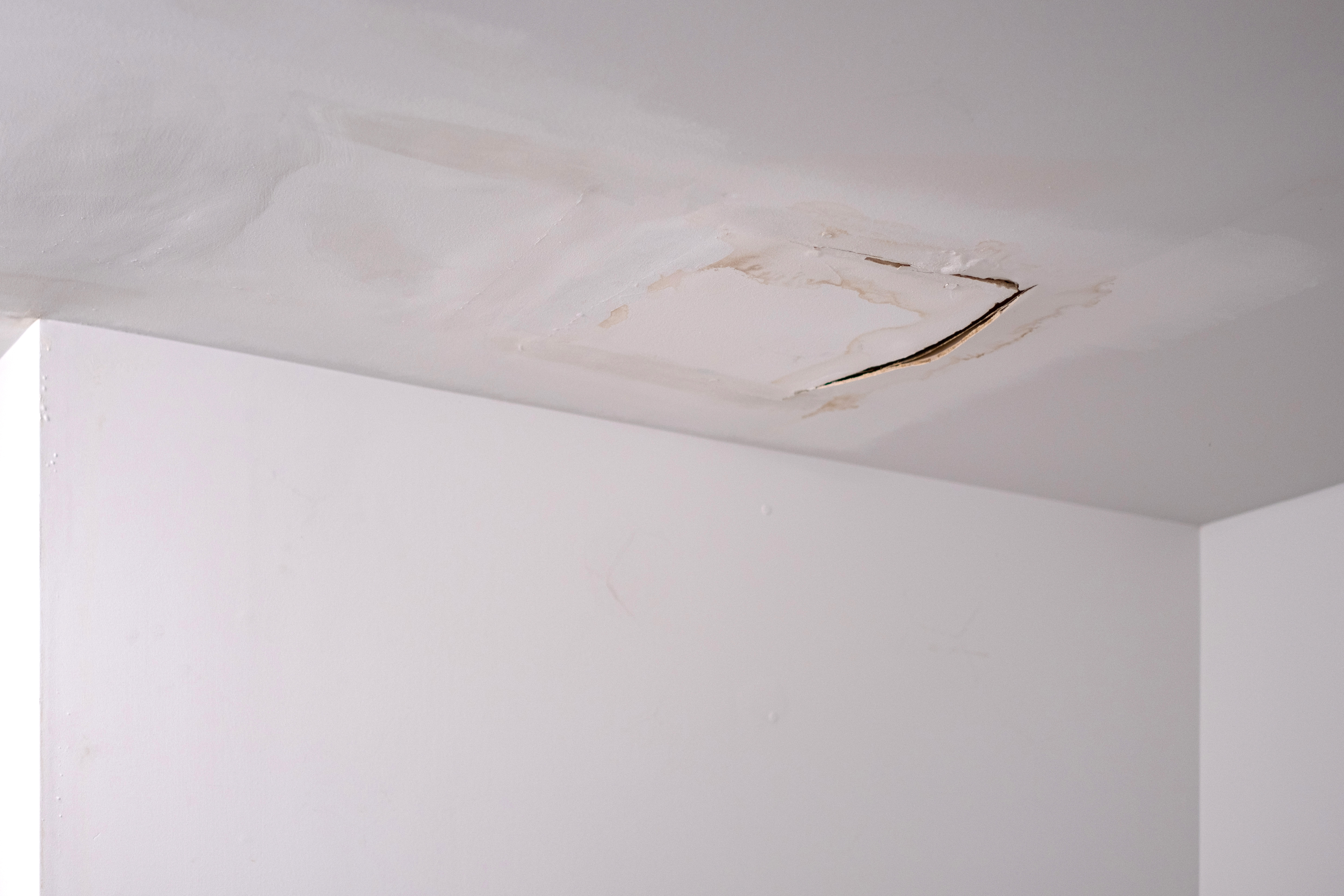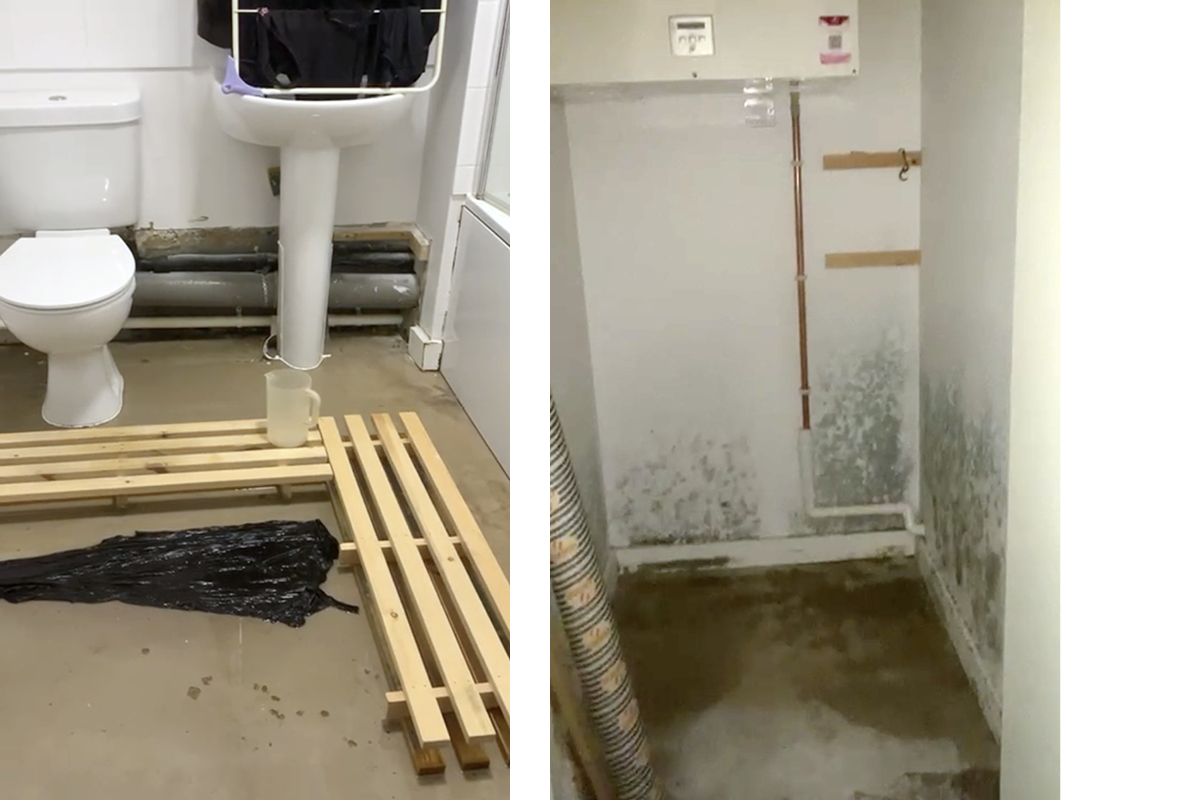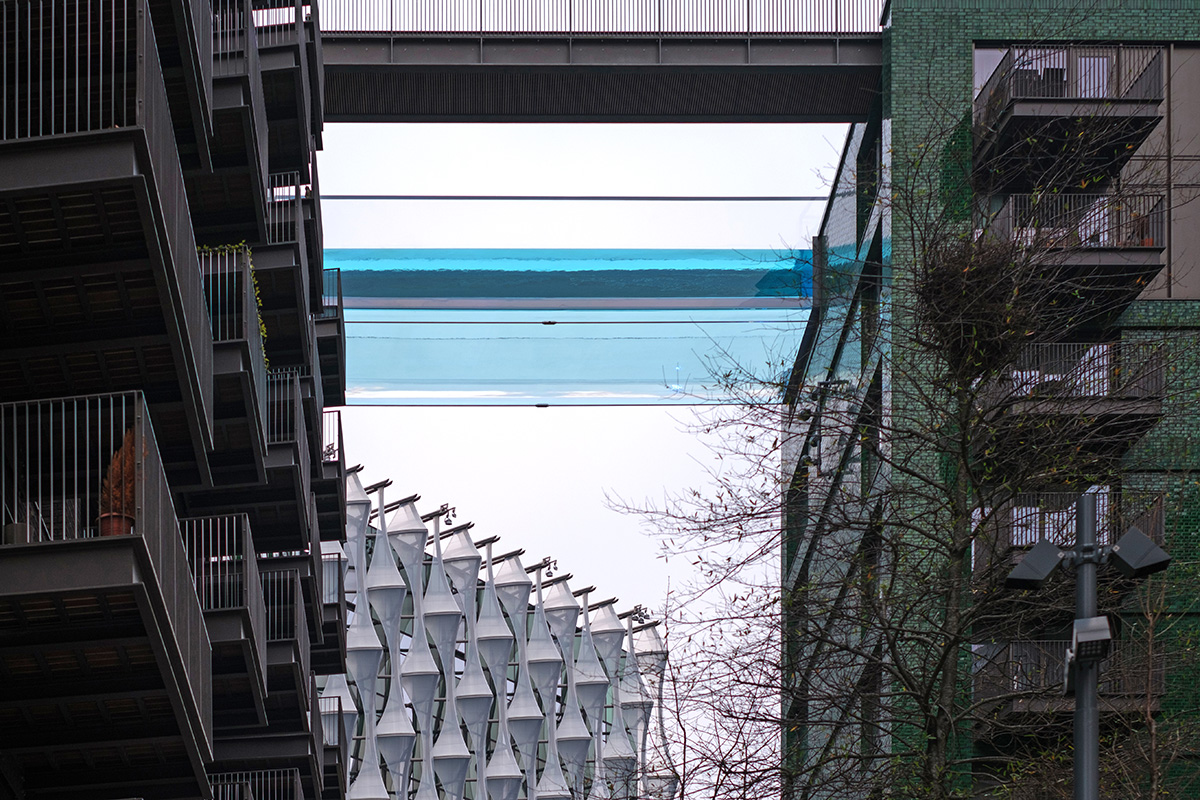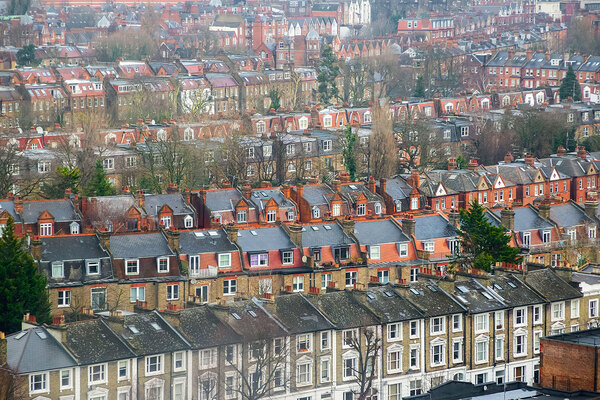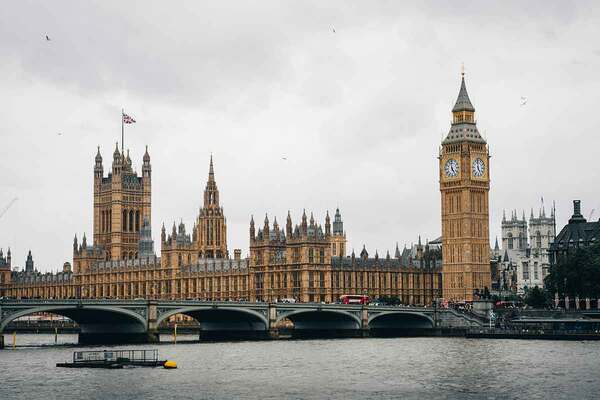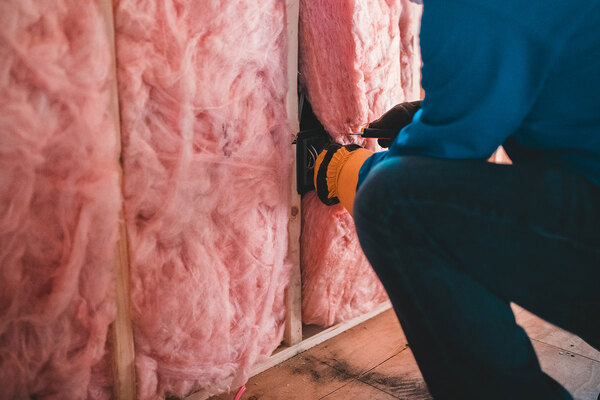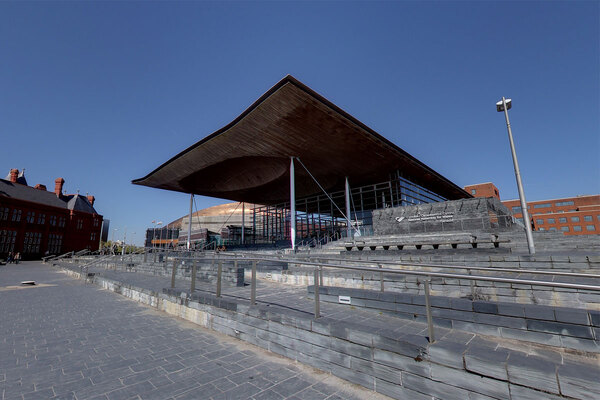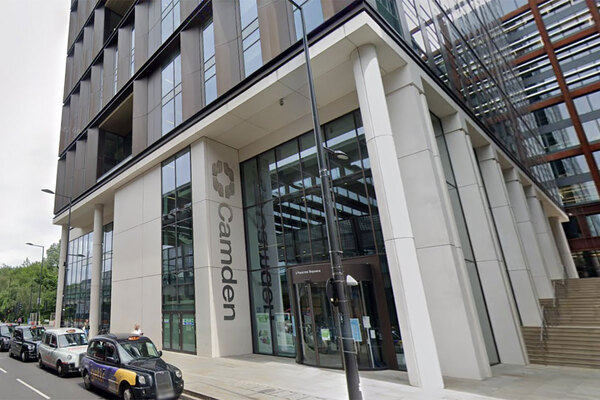What it is like to live in Nine Elms as an affordable housing resident
While the wealthy private owners of flats in Nine Elms enjoy the use of the swimming pool and orangery, affordable housing tenants are struggling to get repairs done. Peter Apps reports. Photography by Hiran Perera
Juliette’s* home is described by her neighbours as a swimming pool. A persistent leak has flooded her flat, walls have been pulled down to find it and her carpets have come up. Getting from the living room to the kitchen involves wading through ankle-deep water. The amount of moisture in her flat means mould is taking hold in the modern-looking apartment, which was completed only four years ago.
Hers is one of two flats on the mezzanine floor in the building (a block of 100 affordable rent flats managed by housing association Southern) which have been particularly impacted by the leaks. Her neighbour moved out months ago, but she remains – afraid to vacate into the insecurity of temporary accommodation.
Juliette is far from the only social housing tenant around the UK to be impacted by damp and leaks. But her situation holds a particular irony.
Because if you look out of her window, you will see a swimming pool of a different kind: the sky pool, floating 115ft in the air and bridging between two buildings in the luxury Nine Elms development on the banks of the River Thames in south-west London.
When Inside Housing visits, on a freezing night in January, the sky pool is glowing purple, mist from its heated water rising into the cold winter air. Along with its bar and orangery, the swimming pool in this landmark private development is only available to the private residents of the new flats, many of whom have paid upwards of £1m for their apartments.
It was a development much discussed in the press – Bloomberg News said the pool “[dangled] a potent symbol of inequality over all of London’s heads”. For those who occupy the ‘affordable’ housing at its base, this is all too literal.
‘Opportunity area’
The Nine Elms development began life as an ‘opportunity area’ identified by Labour mayor Ken Livingstone in 2004, as a place where major housing development could take place and the profits from the sale of private housing would see around 50% of the development made ‘affordable’ – a mix of social rent and some homeownership options.
But as the years passed, this number has been squeezed. Around 18% of Nine Elms has turned out to be affordable, an even smaller percentage has been made available for rent and these rents are at higher ‘affordable’ or ‘London affordable’ rates, well above the social rent levels originally envisaged.
And the residents that do live there now face a repairs crisis and soaring bills for which they struggle to get anyone to take responsibility.
Inside Housing travelled to south-west London to meet some of those impacted. We meet a group of the building’s residents – Marcia, Rose, Derren and Deanne. Most are parents, some of whom spent more than a decade waiting for social housing before moving to Nine Elms. They work in local businesses.
Now they each rent a flat from 77,000-home Southern Housing in the 5 Ponton Road building of the brand new complex, which also houses the US embassy, paying around £1,000 a month for their flats, on top of an £80-a-week service charge (depending on the size of their flat).
“When we first moved in, it seemed like everything was OK until the little cracks started to show,” says Rose. “But it was really hard to get anything fixed. We’d contact Optivo [the previous landlord, which merged into Southern], and they would say, ‘No, we don’t deal with it, you’ll have to go to Ballymore.’ And for us, it was quite frustrating because we don’t pay our money to Ballymore, we pay our rent to Optivo. People were having problems with blocked toilets, with taps that were leaking. One of our residents has had a leaking tap for about two years now.”
This speaks to the wider issue, which is an under-discussed facet in the social housing sector’s repairs crisis: buildings constructed privately and then sold as affordable housing under a Section 106 arrangement often come with complex management arrangements, which make pinning down responsibility for repairs extremely difficult.
Here, the freehold is owned by EcoWorld Ballymore – a joint venture between the Malaysian property company EcoWorld, and Irish developer Ballymore, which developed the Embassy Gardens project. This company sold a lease on the building to Optivo (now Southern), which is responsible for maintenance inside flats, internal communal repairs and the roof garden.
But Ballymore Asset Management Ltd – which shares a registered office and some directors with Ballymore – is contracted as the managing agent and is responsible for the external fabric and structure of the building and some other matters.
This sort of division of responsibilities is common in Section 106 arrangements. It can cause issues for residents seeking to get answers and action taken for housing issues.
One senior source at a London housing association says this has become an increasingly large headache in the capital: “We were all in a rush to grow. And we all bought Section 106 homes without really checking the
fine print.
“What we have to do is try and fight with the managing agent. And what we’ve all done is we’ve gone in where we shouldn’t have legally, and we’ve done repairs. But as money has gotten tighter and tighter, we’ve all had to pull back from doing that and tell the managing agent it’s their responsibility. But ultimately that means taking people to court to get a leak fixed.”
In Ponton Road, the leaks and flooding on the mezzanine floor are the most extreme examples of disrepair. Southern says the resident chose to arrange her own repair work, but that it has identified further work which needs to be done and will complete it this month. But this is not the only issue with the building.
Other tenants such as Deanne have seen their flats impacted by damp – with patches of mould a couple of metres squared-wide appearing on her walls. The leaks are also playing havoc with water bills: Deanne estimates she has paid £1,600 in the past seven months. “I keep calling and they say there’s a leak in the block,” she says. “But they can’t find the leak. My bill has gone from £48 a month to £300 a month.”
The building’s entrance doors have also been a major problem: sometimes they get stuck and do not open, trapping residents, visitors or delivery drivers inside the lobby. At other times they break and are easy to pull open, meaning the stairwell has become a hotspot for rough sleepers, and parcels are regularly stolen. Ballymore is responsible for this, and says it has no outstanding complaints.
Their building actually has a parcel office attached to it, but the social housing residents are excluded from using it. Sometimes their parcels are delivered there in error.
“Getting your parcel back is like World War III,” says Mr Arnold. “The concierge are so rude to us: they say this isn’t for you, you’re not allowed to send your post here. They almost dismiss you like you’re a nobody.”
“Unfortunately because we’re seen as social tenants, there’s a social divide. When we do go and speak to the staff that work at Ballymore, the kind of response we get from them is very poor,” Rose adds. “But we’re paying to live here like everyone else, we just want to be treated with respect.”
Ballymore says that it has not had any complaints about disrespectful staff, but that it will investigate and take action if any are raised.
Overflowing bins, nowhere to park
A bin store downstairs is regularly overflowing with waste, which residents say is often dumped there from other blocks. Southern says this resulted from a “misunderstanding”, which has now been resolved.
And residents – some of whom are disabled and need to drive – have nowhere to park. Deanne needs to squeeze her car into a tiny space outside the building and change the ticket on it every three hours to avoid a parking fine. Their building is equipped with underground parking, but this is for the exclusive use of residents in private blocks, whose cars are valet parked there by the concierge.
On top of these problems is a major issue with energy and water bills. Every flat in the building has its energy supplied by a district heating network for the building. Residents need to top up their individual meters with an app to pay for heating, but their bills are extraordinary. “I got through £90 in just under two weeks without turning the heating on,” says Deanne. “If you put the heating on, the credit disappears in a matter of hours.”
Added to this, due to difficulties calculating the bills, all the meters in the building were suddenly placed in debt in August. Derren’s went from £47 in credit to £600 in debt overnight. The residents have now had to sign up to direct debits to pay off this debt, on top of their day-to-day energy bills.
A source with knowledge of the heating network says it has experienced regular problems since the development was completed: the connectivity will sometimes drop out, meaning when residents pay to top up their meters, the payment does not always go through. It also means bills are not always applied immediately, and instead added as a lump sum when the system comes back online.
The system will also shut down completely from time to time, leaving residents without heat and hot water.
The huge rise in energy bills following the war in Ukraine also hit the network hard, but these changes were not applied to the bills until 2022, meaning they have appeared as a deficit.
The upshot is that residents now face bills which simply mean the affordable housing (which was already at the limits of their affordability) is no longer affordable in any sense. At least one is planning to move out of London as a result (see statement from Evinox below).
The residents had a meeting with Southern in September, where all of these issues were raised.
“They listened, they noted everything down, they said it would be taken care of, but we’ve heard nothing since,” says Marcia.
A spokesperson for Southern says the organisation will be sending more detail out in a newsletter next month, and is encouraging residents to form an action group to help raise concerns. A spokesperson for EcoWorld Ballymore adds that its managing agent is “committed to ensuring all residents receive the highest-quality estate services and experience” and will “continue to work closely with Southern Housing… to ensure this is delivered”.
But a fundamental issue at the heart of this is the process of Section 106, and the complex arrangements it leaves behind.
Fiona Fletcher-Smith, chief executive of L&Q, explains that the landlord has 22,000 residents in homes managed through Section 106 agreements, with around 360 different types of agreement in place covering all of these scenarios.
“The reason L&Q have pulled out of Section 106 is that we have too many of these complicated, messy arrangements and the only people suffering at the end of the day are the residents,” she says.
Others are taking a different route. Helen Moore, group director of Orbit Homes, says the organisation has moved to primarily building its own developments, but will continue to keep around 35% of its pipeline as Section 106.
“At the moment Section 106 deals are very competitively priced because many landlords are stepping away. But the key is understanding what you’re signing up to,” she says.
Orbit has negotiated a doubling of the warranty periods on the units it buys, negotiates up the specifications before they are built and works only with “known trusted” partners to set up a sensible management arrangement.
“You absolutely can make s106s work and frankly we have to do so,” she says. “Because that’s the way many new affordable homes are delivered and as a responsible HA we need to be there to take them on, in our area of operation.”
But in the schemes where it has not worked, the headache for residents of being bounced from one organisation to another will likely continue.
“There were six of us in a two-bed flat when I moved here,” says Deanne. “But knowing what I know now, I would stay there. This place is 24-hour stress, and it just isn’t worth it.”
Responses
A spokesperson for EcoWorld Ballymore says: “5 Ponton Road was sold to Southern Housing Group on a 150-year headlease in 2018. As the building freeholder, EcoWorld Ballymore and the managing agent, Ballymore Asset Management Ltd (BAML), are committed to ensuring all residents receive the highest quality estate services and experience. We will continue to work closely with Southern Housing, the owner of the affordable housing apartments within the building, to ensure this is delivered.
“Where issues relating to the building structure, insurance, access control and fire alarm system are reported to BAML, every effort is made to resolve them as quickly as possible. All other matters relating to the affordable housing apartments, internal common parts and associated services, are the responsibility of Southern Housing.”
A Southern spokesperson says: “We’re aware of a leak which affected two of our homes on the mezzanine floor over a year ago.
“The leak came from a pipe in one of the homes and affected the other flat. We had issues accessing the flat where the leak came from and eventually had to force entry.
“The resident in the other home was offered hotel accommodation and a serviced apartment due to the damage caused, but preferred to remain in her own flat. She chose to organise her own repair work, but we have since visited to check the standard of the repairs.
“We’ve identified further work which needs to be carried out. We’re scheduled to carry out this work later this month.”
On issues with heating, it adds: “The supply of hot water and heating through the communal heat network are the responsibility of the freeholder, which is common with Section 106 agreements.
“Residents’ bills are based on usage and charged on a cost-recovery basis. We’re unaware of any large debits being placed on our residents’ accounts and we’d urge any residents affected to reach out to us.
“We encourage all residents to get in touch with us if they’re struggling to pay their energy bills, even though we have little say over the cost of fuel supplying the heat network, its efficiency, or the heat tariff.
“We have a dedicated financial inclusion team in place to offer support and advice to our residents. Residents can also find useful information on our website.”
On communication with residents, it adds: “We know the importance of strong communication and are planning a regular newsletter in partnership with Ballymore.
“Our team are due to share the first newsletter later this month, which will cover the issues raised in September. We’re also looking into setting up a Resident Action Group and will speak to residents about this, highlighting the benefits of a formal group representing all residents moving forward.”
A spokesperson for Evinox, which is the billing provider for the heat network, says: “We operate a pay as you go system and provide the infrastructure for residents to make payments for their heating and hot water usage on an as-needed basis. These payments recover the costs incurred by the heat supplier providing energy for the development.
“We are aware of a number of issues that have both impacted the operation of the heat network and stopped the pay as you go system connecting to residents’ meters. At times, this has prevented the residents from receiving heat. We are very aware of the impact this has had on the residents and we are very sorry for the issues this has caused.
“Although these issues have not been in our control, we are working hard with the heat supplier and other parties to prevent them from occurring. We are also reviewing our own processes to see what we can do to improve communications and minimise the impact of any reoccurrence in the future.
“Gas prices increased dramatically in 2022. There is an inherent delay between the costs varying and those changes being applied to the rate residents are charged for their heating and hot water consumption. This has resulted in a deficit, which when applied to the pay as you go system appears as arrears. We are working to ensure that residents are continuing to benefit from heating and hot water, while agreeing payment plans with them to reduce arrears.”
Sign up for our asset management newsletter
Already have an account? Click here to manage your newsletters
